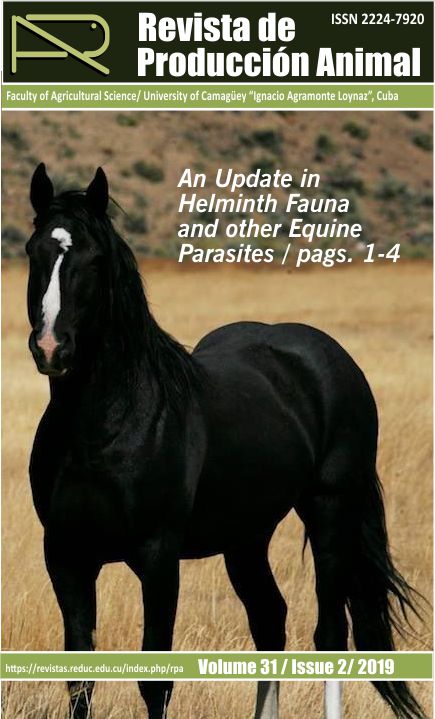Growth Trait Heredity in Two Cavy Sublines Native to the Ecuadoran Mountain Range
Resumen
Background: No studies have been published on South American cavy preservation and breeding programs; therefore, the aim of this article was to analyze the genotypic and environmental factors that act upon the growth traits of a South American native cavy line found in the Ecuadoran Mountain Range.
Methods: The study took place on Irquis experimental farm, from the Faculty of Agricultural Sciences, University of Cuenca, using two native cavy sublines from rural breeders in provinces Azuay and Cañar. Weight per age and daily weight gain (g) were analyzed by a mixed variance analysis of litter size (5), season (semester), sex, and parturition number of the mother as fixed effects, using software R 3.4.4. The random effects were made by sub-lines Azuay (1) and Cañar (2), and their male parents. The basic statistical values were determined.
Results: Birth weight, weaning weight, and weight at 90 days in grams, were 110.2 ± 1.81, 117.0 ± 1.44; 212.2 ± 4.30 and 221.13 ± 3.38; 540.7 ± 12.01, and 659.1 ± 9.44, respectively. The heredity values for these traits were 0.09 ± 0.101, 0.34 ± 0.201, and 0.11 ± 0.111. Besides, weight was analyzed at 30, 45, 60, 75, and 90 days after birth, which included gains at every age. The BLUP predictors for the parents of the two sub-lines were determined. Variation and heritability allowed for selection of weight at weaning and at 90 days.
Conclusions: This line showed low growth levels, though the variations observed were adequate. Their heredity might lead to the expected favorable results, provided a selection program is implemented in the mid-term.
Descargas
Citas
Avilés, D. E. (2016). Caracterización genética del cuy doméstico de América del Sur mediante marcadores molecu-lares. Córdoba, España: Departamento de Genética, Universidad de Córdoba.
Chauca, L. Z. (1997). Producción de cuyes (Cavia porcellus). Perú: Estudio FAO.
FAO. (1997). Lista mundial de vigilancia para la diversidad de los animales domésticos (2da ed.). Organización de las Naciones Unidas para la Alimentación y la Agricultura, FAO UNEP. Retrieved on April 14, 2019, from https://www.fao.org/docrep/V8300S/V8300S00.htm.
Hernández, C. (2015). Efecto del sexo y edad de sacrificio sobre los quintos cuartos y la calidad de la canal de cuy. Riobamba, Ecuador: Facultad de Ingeniería, Universidad Nacional de Chimborazo.
Kouakou N. D., Grongnet, J. F., Assidjo, N. E., Thys, E., Marnet, P. G., Catheline, D., Legrand, P., & Kouba, M. (2013). Effect of a supplementation of Euphorbia heterophylla on nutritional meat quality of Guinea pig (Cavia porcellus L.). Meat science, 93(4), 821-826.
Malagón M. A. P. y Meza A. M. (2013). Pasto Guatemala (Tripsacum laxum) con maní forrajero (Arachis pintoi) en la alimentación de cuyes (Cavia porcellus linnaeus) en la etapa de engorde en la Maná-Cotopaxi, Ecuador. Retrieved on April 14, 2019, from http://biblioteca.uteq.edu.ec/cgi-bin/koha/opac-detail.pl?biblionumber=3403& query_desc=su%3A%22MANI %20FORRAJERO%22
Meza, E. R.; Raymondi, J. C. y Cisneros, S. A. (2017). Evaluación Genética de un Plantel de Cuyes Reproductores de Genotipo Perú. Rev Inv Vet Perú, 28(2), 293-298.
Mínguez, C. y Calvo, A. (2018). Effect of supplementation with fresh orange pulp (Citrus sinensis) on mortality, growth performance, slaughter traits and sensory characteristics in meat guinea pigs. Meat Science, 145 (1), 51-54.
R versión 3.4.4. (2018). The R Foundation for Statistical Computing. Vienna, Austria
Remache, R. (2016). Progresión de la calidad de la canal, vísceras, pH y color de la carne de cuy a los 3, 4 y 6 me-ses de edad. Riobamba, Ecuador: Facultad de Ingeniería, Universidad Nacional de Chimborazo
Rodríguez, H. L.; Palomino, M. T.; Hidalgo, V. L. y Gutiérrez, G. R. (2013). Efectos de factores fijos y al azar sobre el peso al nacimiento y al destete en cuyes de la costa central del Perú. Rev. Inv. Vet. Perú, 24 (1), 16-24.
Rodríguez, H. L.; Gutiérrez, G. R.; Palomino, M. T. y Hidalgo, V. L. (2015). Características Maternales al Nacimien-to y Destete en Cuyes de la Costa Central del Perú. Rev. Inv. Vet. Perú, 26(1), 77-85.
Sánchez, X.G.P.; Barrera, S.Z.; Orozco, T.O.; Torres, S. F. M. S. y Monsivais, R.I. (2013). Modelo animal multicarác-ter para la estimación de parámetros genéticos del Cavia porcellus en Colombia. Revista Cubana de Ciencia Agrícola, 36(1), 19-24.
Swiger l. A., W. R. Harvey, D. O. Everson and K. E. Gregory. (1964).The Variance of Intraclass Correlation Involving Groups with One Observation. Biometrics, 20 (4), 818-826.
Tuquinga F. (2011). Evaluación de diferentes niveles de desecho de quinua en la etapa de crecimiento y engorde de cuyes. Riobamba, Ecuador: Escuela Superior Politécnica de Chimborazo.
Vargas, A. P. (2015). Estimación de parámetros genéticos en cuyes utilizando ASReml-R. Anales Científicos, 76 (2), 393-395.
Vargas, A. P.; Gutiérrez, G. R. y Mamani, G. M. (2015). Una Aplicación del Muestreo de Gibbs en la Estimación de Parámetros Genéticos en Cuyes Utilizando MCMCglmm. Rev Inv Vet Perú, 26(2), 182-188.
Los autores de los artículos publicados en RPA retienen los derechos de autor de su trabajo, de marca y patente, y también sobre cualquier proceso o procedimiento descrito en el artículo, así como a compartir, copiar, distribuir, ejecutar y comunicar públicamente el artículo publicado en la RPA o cualquier parte de aquel siempre que indiquen la fuente de publicación (autores del trabajo, revista, volumen, número y fecha), pero están de acuerdo en que la revista publique los trabajos bajo una licencia Creative Commons.
![]() Licencia Attribution-NonCommercial 4.0 International (CC BY-NC 4.0)
Licencia Attribution-NonCommercial 4.0 International (CC BY-NC 4.0)






































